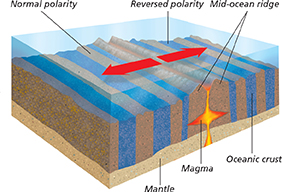Subduction of Oceanic Plates
As sea-floor spreading occurs, old oceanic plates sink into the mantle in the process of subduction. Subduction occurs near the edges of oceanic plates in regions called subduction zones. As a plate sinks through a subduction zone, it bends, forming a depression in the ocean floor called a trench. Subduction occurs because as an oceanic plate moves away from the mid-ocean ridge, it gradually cools and becomes more dense. During subduction, the force of gravity slowly pulls the dense edges of oceanic plates into the mantle, destroying old ocean floor. Sea-floor spreading and subduction together act like a giant conveyor belt.  Sea-floor spreading creates new oceanic crust at mid-ocean ridges. Subduction destroys old oceanic crust at subduction zones. As a result, the ocean floor is renewed about every 200 million years. Over time, these processes change the size and shape of the oceans.
Sea-floor spreading creates new oceanic crust at mid-ocean ridges. Subduction destroys old oceanic crust at subduction zones. As a result, the ocean floor is renewed about every 200 million years. Over time, these processes change the size and shape of the oceans.
Evidence for Sea-floor Spreading
Other scientists soon provided convincing evidence for Hess's theory. They sampled rocks on both sides of the mid-ocean ridge. They found patterns of parallel magnetic “stripes” that were identical on the two sides. The stripes exist because Earth's magnetic field has reversed itself many times in the past. The stripes formed when Earth's magnetic field caused rock crystals to line up in a certain way before the rock fully solidified. The stripes showed that new ocean floor was being added to both sides of the mid-ocean ridge at roughly the same rate. This pattern of stripes is shown in Figure 27.
Figure 27 The pattern of magnetic stripes in the rock of the ocean floor is the same on both sides of the mid-ocean ridge.
Relating Cause and Effect Why is the pattern of stripes the same on both sides of the ridge?

Geologists used radioactive dating to determine the ages of rock samples from the ocean floor. They found that rocks nearer the midocean ridge were younger, and the rocks farther from the ridge were older.
The Theory of Plate Tectonics
The evidence of sea-floor spreading provided what was missing from Wegener's hypothesis—a way for pieces of the crust to move. With this knowledge, geologists developed the theory of plate tectonics during the 1960s. According to the theory, Earth's plates are constantly moving, each with a different rate and direction.
What force is powerful enough to move the heavy continents? Look at Figure 28 on page 680. Convection currents form in the mantle as hot rock rises at mid-ocean ridges, cools and spreads out horizontally as ocean lithosphere, and then sinks back into the mantle at subduction zones. These sinking slabs of cold and dense lithosphere, combined with the rising heat from within Earth, drive the circulation of convection currents in the mantle.  Plate motions are the visible part of the process of mantle convection.
Plate motions are the visible part of the process of mantle convection.





